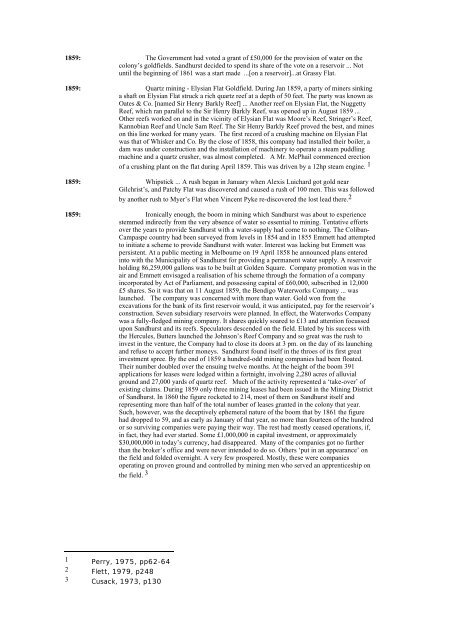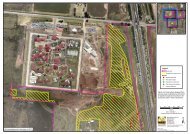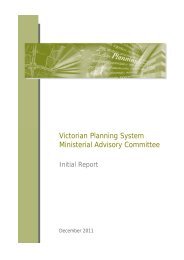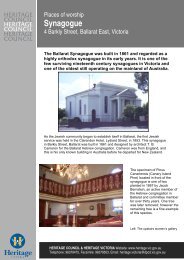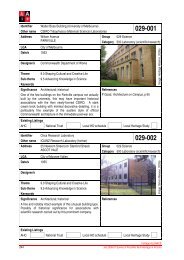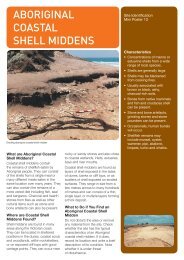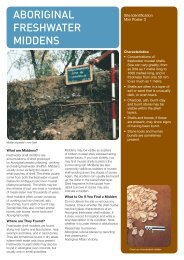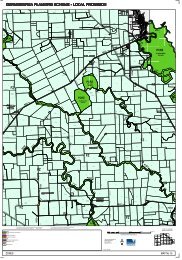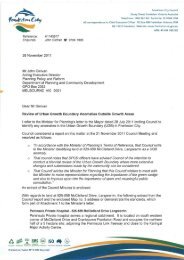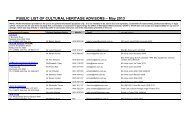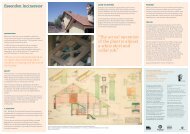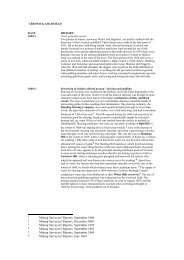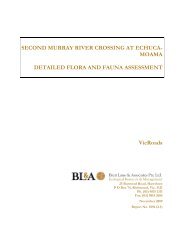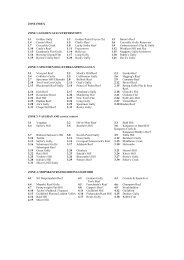Bendigo General History - Department of Planning and Community ...
Bendigo General History - Department of Planning and Community ...
Bendigo General History - Department of Planning and Community ...
You also want an ePaper? Increase the reach of your titles
YUMPU automatically turns print PDFs into web optimized ePapers that Google loves.
1859: The Government had voted a grant <strong>of</strong> £50,000 for the provision <strong>of</strong> water on the<br />
colony’s goldfields. S<strong>and</strong>hurst decided to spend its share <strong>of</strong> the vote on a reservoir ... Not<br />
until the beginning <strong>of</strong> 1861 was a start made ...[on a reservoir]...at Grassy Flat.<br />
1859: Quartz mining - Elysian Flat Goldfield. During Jan 1859, a party <strong>of</strong> miners sinking<br />
a shaft on Elysian Flat struck a rich quartz reef at a depth <strong>of</strong> 50 feet. The party was known as<br />
Oates & Co. [named Sir Henry Barkly Reef] ... Another reef on Elysian Flat, the Nuggetty<br />
Reef, which ran parallel to the Sir Henry Barkly Reef, was opened up in August 1859 ...<br />
Other reefs worked on <strong>and</strong> in the vicinity <strong>of</strong> Elysian Flat was Moore’s Reef, Stringer’s Reef,<br />
Kannobian Reef <strong>and</strong> Uncle Sam Reef. The Sir Henry Barkly Reef proved the best, <strong>and</strong> mines<br />
on this line worked for many years. The first record <strong>of</strong> a crushing machine on Elysian Flat<br />
was that <strong>of</strong> Whisker <strong>and</strong> Co. By the close <strong>of</strong> 1858, this company had installed their boiler, a<br />
dam was under construction <strong>and</strong> the installation <strong>of</strong> machinery to operate a steam puddling<br />
machine <strong>and</strong> a quartz crusher, was almost completed. A Mr. McPhail commenced erection<br />
<strong>of</strong> a crushing plant on the flat during April 1859. This was driven by a 12hp steam engine. 1<br />
1859: Whipstick ... A rush began in January when Alexis Luichard got gold near<br />
Gilchrist’s, <strong>and</strong> Patchy Flat was discovered <strong>and</strong> caused a rush <strong>of</strong> 100 men. This was followed<br />
by another rush to Myer’s Flat when Vincent Pyke re-discovered the lost lead there. 2<br />
1859: Ironically enough, the boom in mining which S<strong>and</strong>hurst was about to experience<br />
stemmed indirectly from the very absence <strong>of</strong> water so essential to mining. Tentative efforts<br />
over the years to provide S<strong>and</strong>hurst with a water-supply had come to nothing. The Coliban-<br />
Campaspe country had been surveyed from levels in 1854 <strong>and</strong> in 1855 Emmett had attempted<br />
to initiate a scheme to provide S<strong>and</strong>hurst with water. Interest was lacking but Emmett was<br />
persistent. At a public meeting in Melbourne on 19 April 1858 he announced plans entered<br />
into with the Municipality <strong>of</strong> S<strong>and</strong>hurst for providing a permanent water supply. A reservoir<br />
holding 86,259,000 gallons was to be built at Golden Square. Company promotion was in the<br />
air <strong>and</strong> Emmett envisaged a realisation <strong>of</strong> his scheme through the formation <strong>of</strong> a company<br />
incorporated by Act <strong>of</strong> Parliament, <strong>and</strong> possessing capital <strong>of</strong> £60,000, subscribed in 12,000<br />
£5 shares. So it was that on 11 August 1859, the <strong>Bendigo</strong> Waterworks Company ... was<br />
launched. The company was concerned with more than water. Gold won from the<br />
excavations for the bank <strong>of</strong> its first reservoir would, it was anticipated, pay for the reservoir’s<br />
construction. Seven subsidiary reservoirs were planned. In effect, the Waterworks Company<br />
was a fully-fledged mining company. It shares quickly soared to £13 <strong>and</strong> attention focussed<br />
upon S<strong>and</strong>hurst <strong>and</strong> its reefs. Speculators descended on the field. Elated by his success with<br />
the Hercules, Butters launched the Johnson’s Reef Company <strong>and</strong> so great was the rush to<br />
invest in the venture, the Company had to close its doors at 3 pm. on the day <strong>of</strong> its launching<br />
<strong>and</strong> refuse to accept further moneys. S<strong>and</strong>hurst found itself in the throes <strong>of</strong> its first great<br />
investment spree. By the end <strong>of</strong> 1859 a hundred-odd mining companies had been floated.<br />
Their number doubled over the ensuing twelve months. At the height <strong>of</strong> the boom 391<br />
applications for leases were lodged within a fortnight, involving 2,280 acres <strong>of</strong> alluvial<br />
ground <strong>and</strong> 27,000 yards <strong>of</strong> quartz reef. Much <strong>of</strong> the activity represented a ‘take-over’ <strong>of</strong><br />
existing claims. During 1859 only three mining leases had been issued in the Mining District<br />
<strong>of</strong> S<strong>and</strong>hurst. In 1860 the figure rocketed to 214, most <strong>of</strong> them on S<strong>and</strong>hurst itself <strong>and</strong><br />
representing more than half <strong>of</strong> the total number <strong>of</strong> leases granted in the colony that year.<br />
Such, however, was the deceptively ephemeral nature <strong>of</strong> the boom that by 1861 the figure<br />
had dropped to 59, <strong>and</strong> as early as January <strong>of</strong> that year, no more than fourteen <strong>of</strong> the hundred<br />
or so surviving companies were paying their way. The rest had mostly ceased operations, if,<br />
in fact, they had ever started. Some £1,000,000 in capital investment, or approximately<br />
$30,000,000 in today’s currency, had disappeared. Many <strong>of</strong> the companies got no further<br />
than the broker’s <strong>of</strong>fice <strong>and</strong> were never intended to do so. Others ‘put in an appearance’ on<br />
the field <strong>and</strong> folded overnight. A very few prospered. Mostly, these were companies<br />
operating on proven ground <strong>and</strong> controlled by mining men who served an apprenticeship on<br />
the field. 3<br />
1 Perry, 1975, pp62-64<br />
2 Flett, 1979, p248<br />
3 Cusack, 1973, p130


